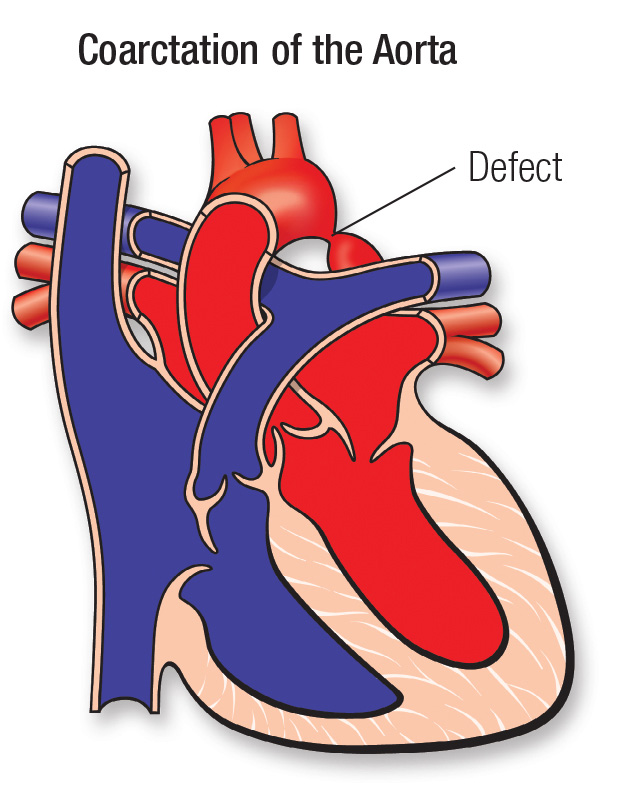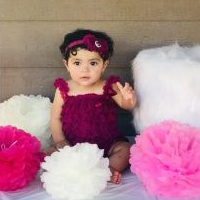Coarctation of the Aorta
What is coarctation of the aorta?
 From heart.org. ©2009, American Heart Association, Inc.
From heart.org. ©2009, American Heart Association, Inc.The aorta is the main blood vessel attached to the heart that supplies blood to the entire body. Coarctation (pronounced koh-ark-TAY-shun) of the aorta means the aorta has a very narrow spot, like an hourglass. Blood pressure increases behind the narrow spot, and the left ventricle has to pump harder against this pressure.
The extra work can make your child’s heart enlarge and make their heart muscle thicken, which lowers the muscle’s ability to squeeze. Without treatment, your child’s heart may not be able to pump enough blood to meet their body’s needs.
This condition develops before birth, but it does not always cause signs or symptoms right away. The causes are not clear.
Some children born with coarctation of the aorta have other heart defects too, such as aortic stenosis, ventricular septal defect, patent ductus arteriosus or mitral valve abnormalities. Coarctation is common in children with Turner syndrome.
Heart Center at Seattle Children's
What are the symptoms of coarctation of the aorta?
Symptoms of coarctation of the aorta happen because the upper parts of your child’s body get too much blood and the lower parts do not get enough.
In mild cases, where the aorta is only slightly narrowed, babies may not have any signs or symptoms at first.
In more severe cases, where the aorta is very narrow, babies may develop serious problems soon after birth because not enough blood can get through the aorta to the rest of their body.
If babies do have symptoms, they might have:
- Trouble breathing
- Poor appetite or trouble feeding
- Failure to thrive
- Arms and legs that are cool to the touch
A child who did not have symptoms as a baby may develop symptoms later in childhood. The symptoms come from problems with blood flow and an enlarged heart. Your child may:
- Feel dizzy or short of breath
- Faint
- Have chest pain
- Be more tired than normal
- Get headaches or nosebleeds
- Have cold legs and feet
- Have pain in their legs when they exercise
How is coarctation of the aorta diagnosed?
Sometimes doctors can diagnose this condition in a developing baby before birth. They might first see something different about your baby’s aorta or heart on standard prenatal ultrasound. To learn more about your baby’s condition, you might have a fetal echocardiogram (an ultrasound done to check the heart more closely). Seattle Children’s Fetal Care and Treatment Center team can care for you when you are pregnant if your developing baby has a known or suspected problem.
Even though the narrow spot is there before birth, doctors might not find and diagnose this condition until later in your child’s life, when a routine exam reveals problems with your child’s pulse or blood pressure.
Your child’s doctor will examine your child, use a stethoscope to listen to their heart and check the blood pressure in their arms and legs. The doctor will ask for details about any symptoms your child has, their health history and your family health history.
To get more information about how their heart looks and works, your child will need some tests. Your child’s doctor will probably want to use echocardiography and an electrocardiogram.
Sometimes, the doctor needs more information and will use chest X-rays, cardiac MRI (magnetic resonance imaging), cardiac CT (computed tomography) scan or angiography. For an older child, doctors may do exercise testing.
How is coarctation of the aorta treated?
Doctors can treat this condition with cardiac catheterization to open the narrow spot in the aorta (balloon angioplasty) or with surgery to remove that part of the aorta. The treatment plan depends on how severe the coarctation is and if there are other birth defects.
-
Catheterization
Some children have their narrow aorta opened using catheterization. This means putting a small tube (catheter) through an artery or vein and threading it up to the narrowed area. Then there are 2 options:
- The doctor can insert a balloon through the tube. When the balloon is inflated, it stretches the aorta open. Then the doctor removes the balloon. This is called balloon angioplasty or balloon dilation.
- The doctor can place a stent at the narrow spot. A stent is a tube-shaped device that can be left inside a blood vessel to hold it open.
-
Surgery
Some children need surgery to improve blood flow through their aorta. These are the options for surgery:
- Cutting above and below the narrow spot, removing it and joining the loose ends of the aorta together
- Making a cut in the narrow spot to widen it and sealing it with an artificial patch or a patch taken from an artery in your child’s arm
- Using a tube to connect the aorta above and below the narrow part
Parent quote:
“To his credit, Dr. Chen put two extremely nervous first-time parents at absolute ease. He expressed nothing but optimism that surgery was the best way forward for Sabina.” ~ Zach Sturges
 Leigh and Zach Sturges knew for months that they were expecting twins. But it was only after delivery that they learned one of their daughters had coarctation of the aorta. Within days, little Sabina, just 3 pounds, had surgery at Seattle Children’s Heart Center.
Leigh and Zach Sturges knew for months that they were expecting twins. But it was only after delivery that they learned one of their daughters had coarctation of the aorta. Within days, little Sabina, just 3 pounds, had surgery at Seattle Children’s Heart Center. -
Hybrid procedure
Some children have a hybrid procedure, which uses both catheterization and surgery. A cardiac surgeon makes cuts to provide access to the aorta. Then a cardiologist inserts a catheter to open the narrow spot. With this method, a child may be able to have catheterization even if they are too small for the tube to be threaded through smaller blood vessels to their aorta.
Along with these treatments, your child may need medicines to treat problems related to their narrow aorta. These medicines may improve the force of their heartbeat or control their blood pressure.
After the narrow spot is opened, it will be important for your child to keep seeing their cardiologist on a regular schedule to check their heart health. People treated for this condition sometimes get a narrow spot again where the repair was done or an aneurysm. With regular visits, your child’s team can check for early signs of conditions like these and make sure your child gets the care they need.
Why choose Seattle Children’s for coarctation of the aorta treatment?
Our surgical outcomes are among the best in the nation year after year.
-
The experts you need are here
- Our team of more than 40 pediatric cardiologists has diagnosed and treated this condition in many babies, children and teens — and we provide the ongoing care patients may need as they grow into young adults.
- Our pediatric cardiac surgeons perform more than 500 procedures yearly. Each has experience correcting aortic coarctation. We can do surgery even for tiny newborns, which not all heart centers can do.
- For the smallest babies, who may be too small for standard surgery, our surgeons and cardiac catheterization specialists work together to perform hybrid procedures.
- We also have a pediatric cardiac anesthesia team and a Cardiac Intensive Care Unit ready to care for children who have heart surgery.
 “It was a scary experience that nobody wants to go through, but I want to thank everyone at the hospital for being there for us and answering every question that we had.”
“It was a scary experience that nobody wants to go through, but I want to thank everyone at the hospital for being there for us and answering every question that we had.” -
Care from before birth through young adulthood
- If your developing baby is diagnosed with coarctation of the aorta before birth, our Fetal Care and Treatment Center team works closely with you and your family to plan and prepare for the care your baby will need.
- Your child’s treatment plan is custom-made. We plan and carry out their surgery, catheterization or hybrid procedure based on the specific details of their condition. As your child grows, we closely check their needs to make sure they get the care that is right for them at every age.
- We have a special Adult Congenital Heart Disease Program to meet your child’s long-term healthcare needs. This program, shared with the University of Washington, transitions your child to adult care when they are ready.
-
Our approach reduces the number of procedures your child needs
- At Seattle Children’s, we set up a quality-improvement project to reduce the number of procedures your child is likely to need for coarctation of the aorta.
- After surgery for this condition, some patients develop a narrow spot where their aorta was repaired. This puts extra stress on their heart. It may mean they need a cardiac catheterization procedure or another surgery to open the aorta again.
- By carefully studying the steps in our surgical approach and the results for our patients, we designed a standard way to repair the aorta with a lower risk of getting a narrow spot in the future.
-
Support for your whole family
- We are committed to your child’s overall health and well-being and to helping your child live a full and active life.
- Whatever types of care your child needs, we will help your family through this experience. We will discuss your child’s condition and treatment options in ways you understand and involve you in every decision.
- Our child life specialists know how to help children understand their illnesses and treatments in ways that make sense for their age.
- Seattle Children’s has many resources, from financial to spiritual, to support your child and your family and make the journey as smooth as possible.
- Many children and families travel to Seattle Children’s for heart surgery or other care. We help you coordinate travel and housing so you can stay focused on your child.
- Read more about the supportive care we offer.
Contact Us
Contact the Heart Center at 206-987-2515 for an appointment, second opinion or more information.
Providers, see how to refer a patient.
Related Links
- See a picture (Medline Plus).
- Adult Congenital Heart Disease Program
- Cardiac Catheterization Procedures
- Heart Center
- Heart Surgery
- Hybrid Heart Procedures
- Fetal Care and Treatment Center
Paying for Care
Learn about paying for care at Seattle Children’s, including insurance coverage, billing and financial assistance.

